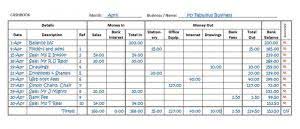Content
When you create an allowance for doubtful accounts entry, you are estimating that some customers won’t pay you the money they owe. The sales method applies a flat percentage to the total dollar amount of sales for the period. For example, based on previous experience, a company may expect that 3% of net sales are not collectible. If the total net sales for the period is $100,000, the company establishes an allowance for doubtful accounts for $3,000 while simultaneously reporting $3,000 in bad debt expense. Estimates are the responsibility of management to improve the accuracy of the presentation of the financial statements. When a receivable exists there is a degree of uncertainty about the collectability of that receivable and per U.S.
- Net receivables are the money owed to a company by its customers minus the money owed that will likely never be paid, often expressed as a percentage.
- And you would also understand whether the allowance you estimated is sufficient or not.
- If the following accounting period results in net sales of $80,000, an additional $2,400 is reported in the allowance for doubtful accounts, and $2,400 is recorded in the second period in bad debt expense.
- Continuing with the example, subtract $100 from $1,000 to get a new balance in “allowance for doubtful accounts” of $900.
- Colgate reports allowances for doubtful accounts as $54 million and $67 million in 2014 and 2013, respectively.
A company estimates future bad debt and accounts for the anticipated loss in the current year. It is consistent with GAAP because the bad debt expense is recorded in the year the corresponding revenue has been recognized. In other words, when you record the sale, you know some of the receivables will not be collected.
Allowance For Bad Debts
Accounting JournalAccounting journal, often known as the book of original entry, is first used to record the company’s accounting record whenever a financial transaction occurs. It’s difficult to comprehend, yet it’s crucial in business operations and accounting. Allowance for doubtful accounts do not get closed, in fact the balances carry forward to the next year. They are permanent accounts, like most accounts on a company’s balance sheet. In the Percentage of Sales Method, the management of a company decides on the flat percentage rate to be applied to the total sales for the period.

Certification program, designed to transform anyone into a world-class financial analyst. Assign a risk Allowance for Doubtful Accounts score to each customer, and assume a higher risk of default for those having a higher risk score.
Stay Up To Date On The Latest Accounting Tips And Training
If a customer ends up paying (e.g., a collection agency collects their payment) and you have already written off the money they owed, you need to reverse the account. Your allowance for doubtful accounts estimation for the two aging periods would be $550 ($300 + $250). Doubtful debt is money you predict will turn into bad debt, but there’s still a chance you will receive the money. Companies have been known to fraudulently alter their financial results by manipulating the size of this allowance. Auditors look for this issue by comparing the size of the allowance to gross sales over a period of time, to see if there are any major changes in the proportion.

As a result, the action also reduces the values of Current assets and Total assets. Debit “allowance for doubtful accounts” in a journal entry in your accounting records by the amount of the uncollectible invoice. Allowance for doubtful accounts 250,000 To record the recovery of one-half of the previously written off receivable from XYZ Corporation.
Purpose Of Allowance For Doubtful Accounts
However, the customers sometimes pay the amount written off as bad debts. When this happens, the balance sheet manager reverses the account by debiting the accounts receivable. In addition, year-end accounts receivable total $100,000 but have an anticipated net realizable value of only $93,000. Neither the $7,000 nor the $93,000 figure is expected to be exact but the eventual amounts should not be materially different. This basic portrait provides decision makers with fairly presented information about the accounts receivables held by the reporting company. When the firm makes the bad debts adjusting entry, it does not know which specific accounts will become uncollectible.
- Know that bad debt expenses must be anticipated and recorded in the same period as the related sales revenue to conform to the matching principle.
- Also, determine the current balance of “allowance for doubtful accounts.” For example, assume the balance of “allowance for doubtful accounts” is $1,000 and the balance of “accounts receivable” is $20,000.
- Here, the allowance serves to decrease the receivable balance to its estimated net realizable value.
- The allowance method represents the accrual basis of accounting and is the accepted method to record uncollectible accounts for financial accounting purposes.
- Company ABC lists 50 customers who buy its products on credit and the total amount owed as of Sept. 30, 2021, is $100,000.
If it uses the ending receivables method, bad debt expense will be $26,600 ($540K x 4% + $5K debit balance). Thus under the percent of sales method, bad debt expense will be $12,400 higher and net income will be lower by that amount. A doubtful debt refers to an account receivable that is likely to become a uncollectible in the future. It is difficult to point out which specific customer is likely to default. For this reason, banks usually create what we call a reserve account for accounts receivable that is likely to become bad debts.
Allowance For Doubtful Accounts Policy
Solvency, The CompanySolvency of a company means its ability to meet the long term financial commitments, continue its operation in the foreseeable future and achieve long term growth. Product Reviews Unbiased, expert reviews on the best software and banking products for your business. Best Of We’ve tested, evaluated and curated the best software solutions for your specific business needs. Business Checking Accounts BlueVine Business Checking The BlueVine Business Checking account is an innovative small business bank account that could be a great choice for today’s small businesses. For more ways to add value to your company, download your free A/R Checklist to see how simple changes in your A/R process can free up a significant amount of cash. Since Allowance for Doubtful Accounts is a Balance Sheet account, the balance will be carried over in the next accounting cycle.
Bad debt refers to a debt you’ve officially accepted as being left unpaid by the customer. It’s money you thought your company would https://www.bookstime.com/ receive, but it remains uncollectible. A doubtful debt remains collectible, but a business doesn’t expect to receive payment for it.
Allowance For Uncollectible Accounts Definition
For many business owners, it can be difficult to estimate your bad debt reserve. Use an allowance for doubtful accounts entry when you extend credit to customers.
Another option for calculating and recording an allowance for doubtful accounts is to compare it to accounts receivable that are already severely overdue and you probably won’t collect. This method isn’t as predictive as others, but it still can provide valuable information to your business. If the predicted allowance is less than the overdue accounts, consider reevaluating your accounts. The allowance for doubtful accounts is also known as the allowance for bad debt and bad debt allowance.
On the balance sheet, the 14k is listed in assets as a deduction, directly below the accounts receivable figure. At end of the year, that 14k figure stays, and new allowances are added. The amount is reflected on a company’s balance sheet as “Allowance For Doubtful Accounts”, in the assets section, directly below the “Accounts Receivable” line item. To record the payment itself, you would then debit cash, and credit accounts receivable. This entry permanently reduces the accounts receivable balance in your general ledger, while also reducing the allowance for doubtful accounts. The allowance for doubtful accounts is easily managed using any current accounting software application.
- Some financial statements display the net AR balance and report the allowance in note format.
- In addition, year-end accounts receivable total $100,000 but have an anticipated net realizable value of only $93,000.
- Next, consider Company ABC has an accounts receivable debit balance of $100,000 as of Sept. 30, 2021.
- In that case, If the payment comes before the end of the reporting period, the impacts of the initial write transactions can be reversed.
- Enabling organizations to ensure adherence with ever-changing regulatory obligations, manage risk, increase efficiency, and produce better business outcomes.
- Subtract the amount of the bad debt from the previous balance of “allowance for doubtful accounts” and from the previous “accounts receivable” balance to determine the new balance of each account.
To protect your business, you can create an allowance for doubtful accounts. When you report the allowance for doubtful accounts at the same time as the sale, it can improve the validity of the financial reports. This can result in a more accurate view of the reporting cycle’s revenue and expenses.
The allowance, sometimes called a bad debt reserve, represents management’s estimate of the amount of accounts receivable that will not be paid by customers. An allowance for doubtful accounts is a contra account that nets against the total receivables presented on the balance sheet to reflect only the amounts expected to be paid. The allowance for doubtful accounts estimates the percentage of accounts receivable that are expected to be uncollectible. However, the actual payment behavior of customers may differ substantially from the estimate.
Free AccessFinancial Metrics ProKnow for certain you are using the right metrics in the right way. Learn the best ways to calculate, report, and explain NPV, ROI, IRR, Working Capital, Gross Margin, EPS, and 150+ more cash flow metrics and business ratios. See the encyclopedia entry Balance sheet for more explanation of the above statement. For working examples of interrelated financial statements and coverage of financial statement metrics, see Financial Metrics Pro. Third, the impact of Allowance for Doubtful Accounts on all four primary financial statements.
Net receivables are the money owed to a company by its customers minus the money owed that will likely never be paid, often expressed as a percentage. How To Write an Effective Dunning Letter | YayPay According to a recent study, 93% of businesses experience late payments, and the average organization writes off 1.5% of its receivables. Whenever a balance sheet is to be produced, these two accounts are netted to arrive at net realizable value, the figure to be reported for this asset.
That’s something that your business needs to account for on the balance sheet. Learn more about this accounting technique, including how to calculate the provision for bad and doubtful debts, right here. The allowance for doubtful accounts is the preferred method of accounting for doubtful accounts. It is a contra-asset account netted against accounts receivable on the balance sheet. The allowance is increased by the provision for doubtful accounts and recoveries of previously written off receivables and is decreased by the write-off of uncollectible receivables.
